#philip of habsburg
Explore tagged Tumblr posts
Text
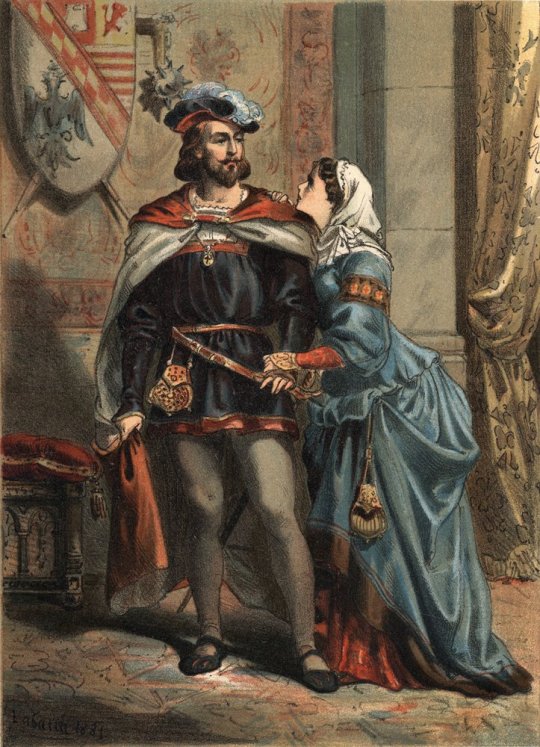
Joanna of Spain known as the Mad (1479-1555), Queen of Castile and her spouse Philip the Handsome (1478-1506), King of Castile and Archduke of Austria in 'El Culto de la Hermosura' by Juan Justo Huguet.
#monarquía española#reyes de españa#juana la loca#reina de españa#viva la reina#casa de trastámara#kingdom of spain#house of trastamara#felipe el hermoso#rey de castilla#archiduque de austria#casa de austria#dinastía habsburgo#philip of habsburg#philip the handsome#joanna the mad#royal couple#engraving#king of castile and león#kingdom of castile#house of habsburg#royalty#el culto de la hermosura#juan justo huguet
13 notes
·
View notes
Text
The Birth of Charles II of Spain Fanart

Warning: This story contains some artistic license
The Queen's pregnancy was approaching its end and had become a matter of utmost importance. The future of the Monarchy depended on this event. On Sunday, November 6, everything seemed to be ready. The doctors and physicians were on alert; the Queen's confessor was near her, and the Chief Steward of her Household was carefully reviewing the arrangement of the items in the birth chamber. To guarantee the success of the event, all the holy relics that were in the Palace and others brought from El Escorial and other places had been arranged in order. There was the staff of Saint Dominic of Silos that the Order of Saint Dominic had brought, the ribbon of Saint John Ortega, from the Order of the Hieronymites; the incorrupt bodies of Saint Isidore and Saint Diego de Alcalá; the image of the Virgin of Solitude and the one so venerated by the royal family, Our Lady of Atocha. It is not easy to find a space so holy and sacred. Everything, then, was ready, the things of the earth arranged to implore God's pleasure. At noon, after a frugal lunch, Philip IV retired to his chambers. At the same time, While eating, Queen Mariana suddenly felt intense pain in her abdomen, realizing that she was about to give birth. She quickly left the table and hurried to the Tower Chamber.
King Philip went straight to his study while looking at Prospero’s portraits. He entered his study, sat down, and began to write to answer the last letter of Sor Maria de Agreda. He wrote with a deep sigh and tears in his eyes.
“ With the long illness of my son, and the continuous help I was giving in his room, I have not answered your letter of the last month...I assure you that what has most exhausted me, more than this loss, is to see clearly that I have vexed God and he sent this punishment to castigate my sins...
(The king reminisces his cherished memories with Felipe Prospero while writing this letter)
Help me as a friend with your prayers to placate God’s just anger and beg Our Lord that, as he took my son from me, He may make his light shine on the Queen, whose confinement we await hourly, and give her good health and guard what is to be born, if his will, for otherwise I do not wish it...
Back in the Tower Chamber, Queen Mariana cries in agony as she is delivering her baby. The royal midwife Ines Ayala told Queen Mariana to push harder. Five other doctors were present at this event in case of emergency. One of those doctors was Dr Bravo. While the Queen was giving birth, the courtiers and Infanta Margarita looked on.
Ah, Sor Maria, If I had succeeded in following your teachings, perhaps I would not have found myself thus. Pray to our Lord that he may open his eyes, that I may perform his holy will in all things... There is nothing new in the English situation. I, thank God am in good health...
At this point, King Philip was interrupted by a courtier who delivered the news and told the events occurring in the Tower Chamber. King Philip was anxious about the future that lay within a few hours. He prayed heavily to God, asking him to deliver him a son. All could imagine the impatience of the Royal Court of Madrid and Europe, waiting for an outcome of this event. As hours passed, Queen Mariana was still in labor, and the doctors argued over natural forms of treatment. They were anxious as the Queen and the child’s life was at stake.
Dr. Bravo proposed a theory: In the past, Queen Mariana had difficult experiences giving birth to her children. At the birth of Maria Ambrosia, Felipe Prospero, and Fernando Tomas, The Queen had terrible epileptic seizures, and the infants died or lived for a short time. On the other hand, at the birth of Infanta Margarita, the only child to survive, The Queen had been perfectly well. Now why was this? The reason is simple: Just before Infanta Margarita was born, Queen Mariana had suffered several violent nosebleeds. Therefore, what she requires now is to be bled.
Some doctors disagreed, warning that the proposed action could endanger the Queen and her child. Concerned, Queen Mariana asked the doctors if there were any alternative procedures. The doctors offered different opinions, while Dr. Bravo defended his proposal. As the debate continued, Mariana went into labor with the assistance of Ines Ayala. The infant cries and is alive. The birth of the infant brought joy to all. King Philip became a father once again. When the courtier informed King Philip of the birth, he was overjoyed and immediately visited the tower chamber to see his newborn son. King Philip joyfully held his son and proudly showed him to the Queen and his daughter. When the courtier informed King Philip of the birth, he was delighted and immediately visited the tower chamber to see his newborn son. King Philip joyfully held his newborn son and showed him to the Queen and his daughter.
Sources:
Carlos, A king who would not die by John Langdon Davis
Happy Birthday, Charles II of Spain!
#all I did is just combine these stories together#history#mariana de austria#spain#art#charles ii of spain#house of habsburg#17th century#habsburg#carlos ii#please like and reblog#my art#Mariana's art#happy late birthday#sorry it took me so long#my cute baby#margarita#margarita maria#philip iv#look at them#i love them so much#they are so cute#espana#kingdom of spain#madrid spain#monarquía española#spanish empire#baroque fashion#baroque#artists on tumblr
64 notes
·
View notes
Text

13 Holy Roman Emperors! 5 Kings of Spain! 4 Emperors of Austria! Like the same 3 nasty chromosomes being inbred around! 1 Holy Roman Empress! The Habsburg dynasty from 1500-1918, from Charles to Charles!
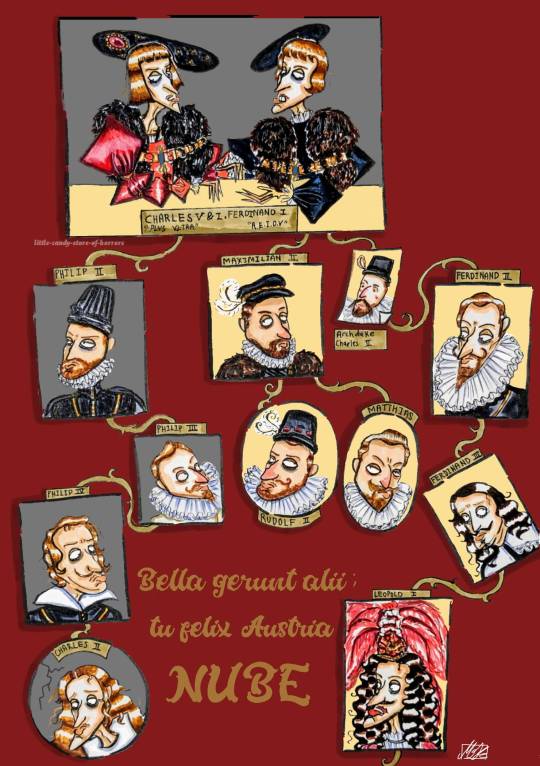
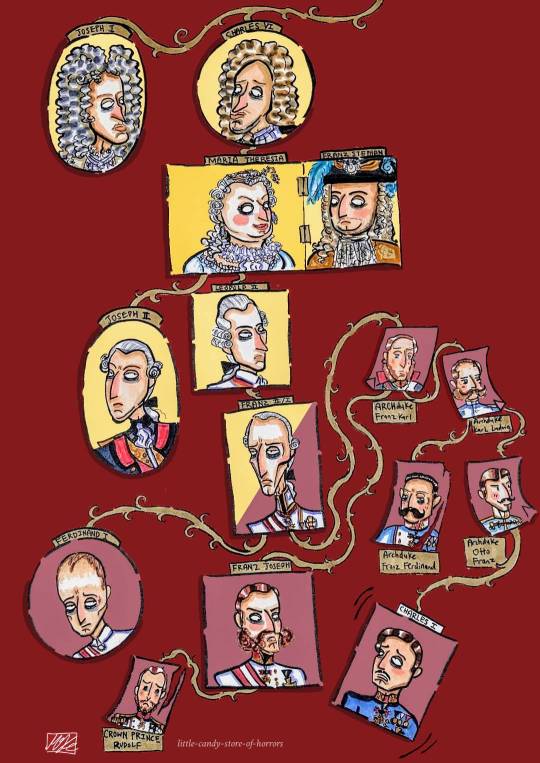
#Ok to reblog!#House of Habsburg#historical art#history art#historical portrait#austrian history#spanish history#Charles v#philip ii#philip iv#carlos ii#maria theresa#Francis ii#franz joseph#Archduke franz ferdinand#crown prince rudolf#16th century#17th century#18th century#19th century#Remember when i said might continue the family wreath to bLeSsEd Karl. Well unfortunately here we are.#Tagging only the most popular folks sorry 😔 tumblr wont let me etc#Something something it starts w the original flag n goes into black for spanish branch gold for HRE n red for austrian empire#Rounded frames for No (legitimate) Heirs#Anyway this is like an a2 sheet IRL
52 notes
·
View notes
Text

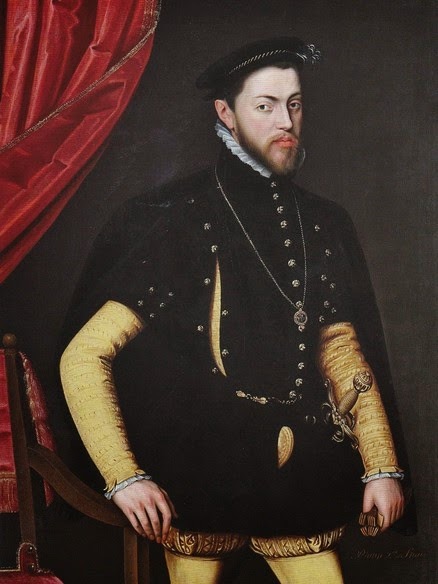
Napoleon II, Duke of Reichstadt
His mother's son (at least for the purposes of this bracket)
Philip II, King of Spain, King of Portugal, reigned 1556-1598
Instant discourse, just say the word 'armada'
251 notes
·
View notes
Text

Charles V (1500-1558) and Philip II (1527-1598). Kings of Spain by Antonio Arias Arias Fernández (1614-1684)
🏛️ Prado Museum. Madrid, Spain
⠀
Shown here on the left is Charles V (1500 – 1558) - head of the rising House of Habsburg. Holy Roman emperor, king of Spain as Charles I, Lord of the Netherlands as Charles II, King of Germany.
On the right is his son king Philip II (1527-1598) - he is resting his right hand on a globe that symbolizes the planetary extent of his possessions. The most powerful ruler of his time.
⠀
- -
Карл V и его сын Филипп II. Портрет работы Антонио Ариаса Фернандеса, 1639-1640
🏛️ Музей Прадо. Мадрид, Испания
⠀
Слева изображен Карл V (1500-1558) – из рода Габсбургов. Король Испании (Кастилии и Арагона) под именем Карлос I, герцог Нидерландский (Карл II), король Германии, Император Священной Римской империи.
Справа - его сын, король Испании Филипп II (1527-1598), опирающийся правой рукой на земной шар, символизирующий планетарные масштабы его владений. Самый могущественный европейский монарх своего времени.
⠀
#king #KingOfSpain #CharlesV #PhilipII #ФилиппII #КарлV #корольИспании
#king of spain#medieval#history#armor#armours#история#harnisch#armadura#armour#искусство#живопись#art#philip ii of spain#Ф��липп II#Charles V#habsburg#Габсбург
31 notes
·
View notes
Text

Philip the Fair (Philip the Handsome), Lord of the Netherlands. By Louis Gallait.
#louis gallait#haus habsburg#the netherlands#Koninkrijk der Nederlanden#Koninkrijk België#Royaume de Belgique#kingdom of belgium#Philip the Handsome#Lord of the Netherlands#duke of burgundy#king of castile#king of leon#duke of brabant#duke of limburg#count of artois#count of holland#count of flanders#count of zeeland#full length portrait#house of habsburg#monarquía española#reyes de españa#rey de castilla#casa de austria#felipe i#felipe el hermoso#full-length portrait#bourgogne#comte de flandre#duc de brabant
15 notes
·
View notes
Text
SIX THE MUSICAL - MODERN!AU: illustration








Lina's family tree 2/2
#Alonso de Aragón y Ivorra#Ana de Gurrea y Gurrea#Juan Hernando de Aragón y Gurrea#Ana Juana de Aragón y Gurrea#Antonio Martin de Aragón y Gurrea#Juana María de Aragón y Nicolás#Bernadino Fernández de Velasco#Juliana Ángela de Aragón y Velasco#Isabella de Castilla Aragón y Trastámara#Afonso Avis#Miguel da Paz de Aragón Avis#Juan de Castilla Aragón y Trastámara#Margaret Habsburg#María Catalina de Aragón Habsburg#Juana de Castilla Aragón y Trastámara#Philip Habsburg#Leonor Isabella de Aragón y Habsburg#Carlos Fernando de Aragón y Habsburg#María de Castilla Aragón y Trastámara#Manuel Avis#João Luís de Aragón Avis#Beatriz Isabella de Aragón Avis#Fernando Afonso de Aragón Avis#María Antónia de Aragón Avis#Henrique Duarte de Aragón Avis#catalina de Castilla Aragón y Trastámara#henry tudor viii#María Valentina de Aragón Tudor#henry felix de Aragón Tudor#anne boleyn
13 notes
·
View notes
Text
Thread about Joanna of Castile: Part : 10 “A Storm of Jealousy: Juana and Philip's Turbulent Reunion"

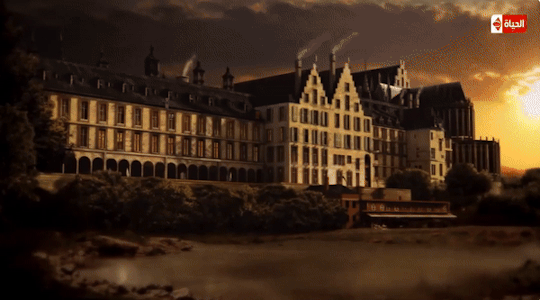
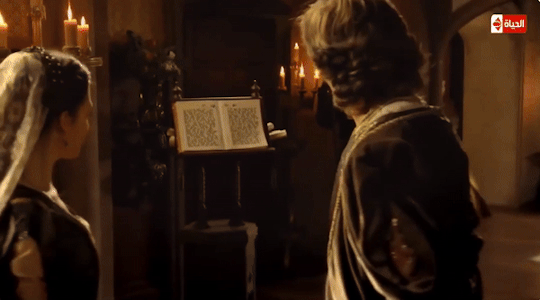
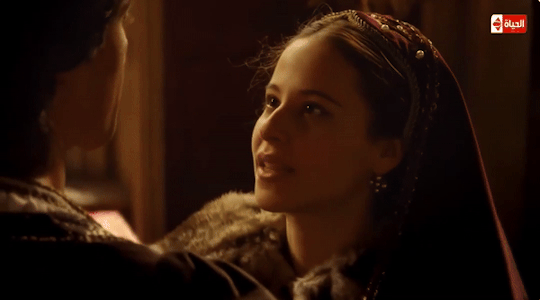
By May 1504, Juana was in Burgundy. Juana’s reunion with Philip and the children was joyful.
But soon afterwards she suspected, or discovered, an affair between Philip and a noblewoman in her entourage:
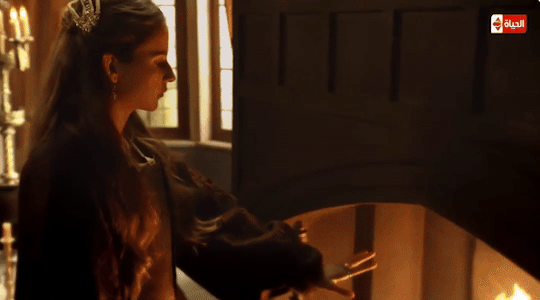



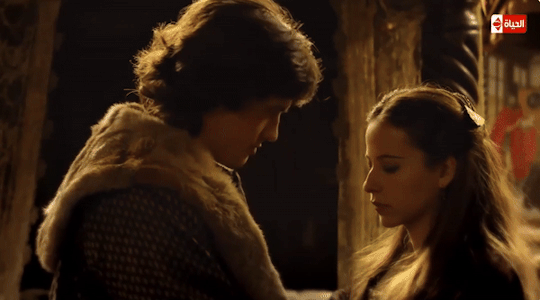

“They say,” writes Martire, “that, her heart full of rage, her face vomiting fames, her teeth clenched, she rained blows on one of her ladies, whom she suspected of being the lover, and ordered that they cut her blond hair, so pleasing to Philip …”


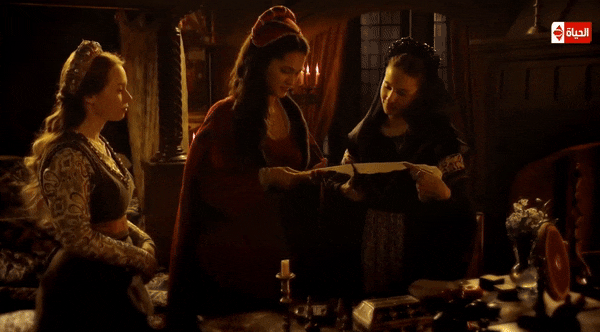
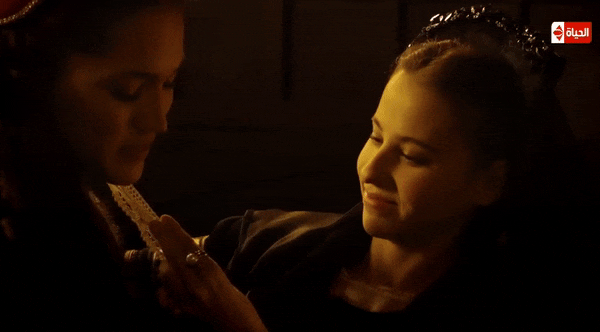
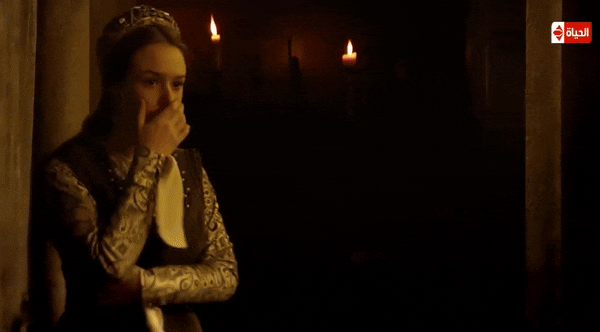

Philip’s response was equally furious. He had “thrown himself” on his wife and publicly insulted her.
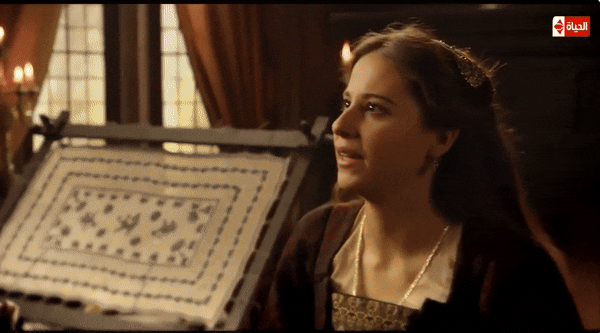


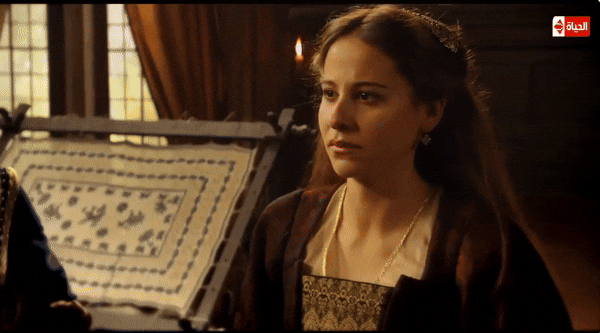
Sensitive and obstinate, “Juana is heartbroken … and unwell …”. Isabel “suffers much, astonished by the northerner’s violence.
Maximilian’s biographer, Wiesfecker, describes Juana’s response as:
"The symptom of a pathological, passionate, if not unfounded, Haßliebe, fomenting continual strife. "
Juana would have known for years about Philip's visits to the baigneries and his more casual relationships with women. However, this affair seemed to pose a direct challenge to her standing and dignity. Juana knew her faults and had tried to limit them. In 1500, after becoming princess, she had asked Isabel to send her an honest and prudent Spanish lady who:
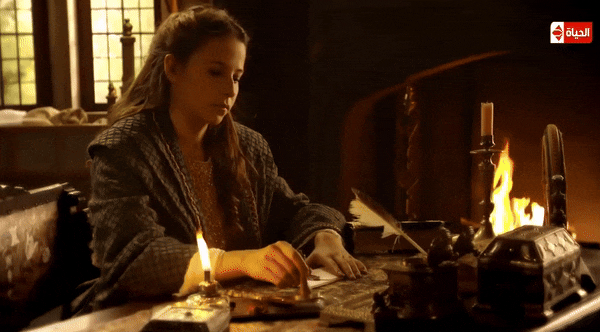



“Knows how to advise her, and where she sees something out of order (‘deshordenado’) in her conduct could say so as servant and adviser but not as an equal because, even if the advice were good, if expressed in a disrespectful way it would create more anger in she to whom it was said than it would allow for correction.”
Sources: Fleming, G. B. (2018). Juana I: Legitimacy and Conflict in Sixteenth-Century Castile (1st ed. 2018 edition). Palgrave Macmillan.
Fox, J. (2012). Sister Queens: The Noble, Tragic Lives of Katherine of Aragon and Juana, Queen of Castile. Ballantine Books.
Gómez, M. A., Juan-Navarro, S., & Zatlin, P. (2008). Juana of Castile: History and Myth of the Mad Queen. Associated University Presse.
#joanna of castile#juana i of castile#juana la loca#philip the handsome#isabel#european history#spanish monarchy#spanish princess#infanta#irene escolar#raul merida#flanders#vlaanderen#Huis Habsburg#House of Valois-Burgundy#Filips I van Castilië#Philippe le Beau
20 notes
·
View notes
Text

Frans Pourbus (Flemish, 1569–1622) Portrait of King Louis XIII of France, 1611 The Cleveland Museum of Art
Pourbus inscribed the sitter’s age and the painting’s year in the composition: “The holy year 1611 at his age of 10 years.” Marie de’ Medici commissioned this work as she negotiated marriages for her two children to Philip III of Spain and Mary Marguerite of Austria, alliances that led to the European domination of the next two centuries by the Bourbon and Habsburg families.
#spanish netherlands#frans pourbus#flemish#flemish art#flanders#1500s#1600s#portait of king louis xiii of france#1611#pourbus#medici#de' medici#de medici#marie de medici#marie de' medici#philip iii of spain#mary marguerite of austria#bourbon#habsburg#art#fine art#european art#classical art#male portrait#europe#king#european#oil painting#fine arts#mediterranean
36 notes
·
View notes
Text

Sor María de Jesús why would you write that. Why would you tell your good buddy Felipe that God hates the way all his wives and daughters and nieces dress. Sor María you and I both know that is a very rude thing to do to an old man with depression.
#felipe iv#philip iv of spain#habsburgs#serious scholarly historical pursuits#(the book is incomparable realms by jeremy robbins)
14 notes
·
View notes
Text

So long as Prince Baltasar lived King Philip resisted all pressure that he should take another wife. The spring and summer were spent in Aragon, in the now almost despairing attempt to win back his dominions from the French. Approaches for his own marriage were made by various interests, but always gently put aside with a reference to his hopes being now centered in his son, whom he kept at his side and instructed him in the business of government. With a wretched lack of material resources his attempts to recover Catalonia were fruitless. One defeat followed another another wearisome reiteration, and as disaster deepened Philip became more moody and devout; his one adviser and confidant being the nun of Agreda, and his one resource agonized prayer. When his boy fell in May 1646, at Pamplona in Navarre, on his way to the seat of war, Phillip's invocations to heaven for his safety were almost terrible in their intensity. The lade recovered and when he arrived with his father at Zaragoza in July, the imperial ambassadors were awaiting them to offer in marriage to the heir of Spain his first cousin, the Archduchess Mariana of Austria, the daughter of the Emperor.
Philip could look nowhere else for an alliance. France was his deadly enemy, though it was governed by his sister Anna as regent, and a further marriage experiment in that direction was out of the question at present, even if there had been an available French princess. The Emperor and Spain, on the other hand, had been – to Spain's ruin – fighting shoulder to should throughout the whole of Thirty Years War, now dragging to its conclusion, and the treaty was promptly signed for the marriage of Baltasar, aged seventeen, with Mariana of Austria, three years younger. With regards to their betrothal, Philip wrote to a nun thus: 'My sister, the Empress, having died, I consider it advisable to draw closer the ties between the Emperor and ourselves in this way, my principal aim being the exaltation of the faith; for it is curtain that the more intimate the two branches of our house are, so much the firmer will religion stand throughout Christendom.
Only two months later, early in October, the blow fell, and the prince died of smallpox. Whilst he was ill, the distracted father wrote frantically to his correspondent, crying for God's mercy to save him from this last trial. But when the boy had died the King's letters assumed a tone of dull despair. God had not heard his prayers, and he supposed it was for the best. He had done everything to dedicate this grief to God; but his heart was pierced, and he knew not whether he lived or dreamed. He was resigned he said, but feared his constancy, and son; each phase revealing a heart that almost doubted the efficacy of prayer and the goodness of the Almighty.
An so history repeated itself; and, as in the case of his grandfather, Philip II, the King accepted for his wife the Austrian princess who had been destined for his daughter-in-law. Of his many illegitimate children he had only legitimized on, Don Juan José of Austria, the son of the actress Maria Calderon. He was brilliant and handsome, and had won his father's regard; but he could never be King of Spain; and Philip, with little enthusiasm, wedded an immature girl for the sake of giving an heir to his country, and for the maintenance of the solidarity of the house of Austria, which typified the old impossible claim of Spain to dictate the religion of the world. It was a disastrous resolve, which ensured the consummation of ruin to the country and cause it was intended to benefit.
#King Philip IV of Spain#Spain#1600s#Mariana of Austria#Habsburg#Prince Balthasar Carlos of Spain#History
2 notes
·
View notes
Text








AU: Mary I of England finally finds happiness in her domestic affairs. Her marriage to Philip of Spain is successful, he loves her and she gives him plenty of children who survive infancy.
These are:
1. Henry IX, King of England, who married a cousin of Spain, Isabella of Austria. Had issue.
2. Charles II, King of Spain, married to Eleanor of Portugal, a cousin. Had issue.
3. Ferdinand, Holy Roman Emperor. Married to a princess of France. Had issue.
4. Catalina, Queen of Portugal. Married to the King of Portugal. Didn’t have issue.
5. Elizabeth, Archduchess of Austria. Married to the the Archduke of Austria. Didn’t have issue.
6. Edward, Duke of York. Married to a cousin of Spain. Had issue.
#alternative universe#tudor dynasty#the tudors#fancast#history au#Mary Tudor x Philip of Habsburg#Mary I x Felipe II#mary of england#queen mary#Queen Mary I of England#queen mary i#king philip ii#Rey Felipe II
6 notes
·
View notes
Text
The Birth of Philip Prospero Fanart

Philip Prospero was born on November 28, 1657, in the Royal Alcazar of Madrid. He was the first son of Philip IV of Spain and Mariana of Austria. His birth brought joy to the kingdom, but his delivery caused his mother to have childbed fever, which most did not notice because of their joy. Queen Mariana was bedridden for days after the birth and she survived.
On the day of the birth, not a bench nor a table was left unbroken in the palace, nor a single pastry-cook’s nor tavern that was not sacked. Tomorrow [December 6] they say that his Majesty will go on horseback to the Atocha to give thanks to the Mother of God… They say the prince is a pretty little chap, and that the King wishes him to be baptized at once, before the extreme cold comes on… There are to be masquerades, bull-fights and cane-tourneys as soon as the Queen stands up to see them, as well as plays with machinery invented by an engineer, a servant of the Nuncio, to be represented at the theatre of Retiro, and the saloon of the palace… The municipality, following the lead of the Councils, have gone to congratulate the King… and no gentleman, great or small, has failed to do the like.
His baptism was described to have some mishaps, starting with the Ceremonial Napkin carried by Condestable de Castilla, an unpopular military officer, He made a scene at Prospero's baptism in the following matter:
It seems that the crush of the people was so great that a staircase gave way; this disarranged the procession as it left the chapel, and in particular prevented the Duque de Bejar from taking his place and bearing away the "mazapan". The "mazapan" was not a sweet meat, but a lump of breadcrumb on which the officiating ecclesiastic wiped his fingers after anointing the child with holy oil. The bread was enclosed in a highly decorated reptacle made of marzipan and carried on a richly worked piece of needlework. It seems to be a object which evoked singular curiosity through little relevance. As the Duque de Bejar was unable to be its barrier, Philip was asked what should be done, he was told master of ceremonies to ask the Condestable De Castilla to substitute, This gentleman replied that he was sorry but he had an injured arm. Philip IV, furious, repeated his order, whereupon he replied, "The Condestable De Castilla are too exalted to fill the gaps and voids left by others. The Duque de Alburquerque carried the ewer, the Duque of Terranova, the salt sellar. Last came the Duque of Pastrana carrying on this occasion the famous mazapan. It was made in the shape of a castle with gold and silver ornamentation. The chrism is a mixture of oil and balm used to anoint the infant. Owing to its Sacrosanct Character, It was those days covered much coveted by ill-intentioned persons; hence the drops of chrism deposited on the bread crumb with the Mazapan might be stolen. The infant was naked at this baptism, At the baptism, the infant was unclothed, prompting the Infanta Maria Theresa to ask why she had to present her brother in this manner. It was explained that this tradition was a way to demonstrate his gender.
Source:
Carlos, A king who would not die by John Langdon Davis
#history#house of habsburg#spain#art#my fanart#habsburg#17th century#please like and reblog#Mariana's art#philip prospero#margarita teresa#maria theresa of spain#maria theresa#philip iv#baroque fashion#baroque#tw childbirth#mariana de austria#artists on tumblr#charles ii fanart soon#sorry for the delay#church#baptism#my art#spanish history#european history#royal history#mom and child
61 notes
·
View notes
Text
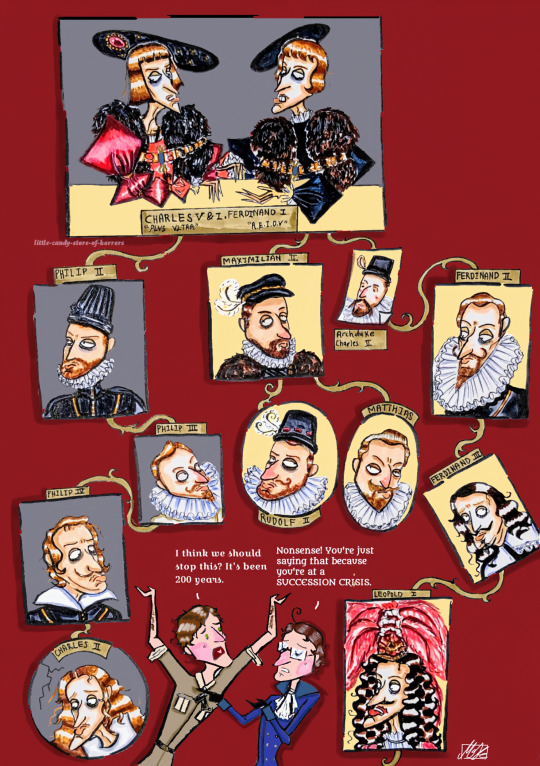
"Bella gerunt alii, tu felix Austria nube!"
Day 6 of @spaus-week 's challenge
"Let others wage war, you, happy Austria, marry!" Was the political strategy of the Habsburgs, and marry did the House of Austria! Infamously, scandalously, sensationally. A mangled wreath of a family tree. We all know this horror story. And we all know the bitter end.
After Emperor Charles V&I divided his Spanish and Austrian inheritance ((also gained through his parents' and grandparents' marriages)) to his descendants and those of his younger brother Ferdinand I respectively, the Habsburg dynasty split into two branches. The Spanish and Austrian Habsburgs notoriously intermarried for generations, right up till Charles II of Spain whose heirless death in 1700 sparked the War of the Spanish Succession. The inbreeding and this informal Latin motto behind it has been blamed to hell and back for their implosion, for the physical ugliness that ran in this royal bloodline. But it is not to say the Habsburgs never went to war, nor that dynastic marriage was a political strategy unique to them! But they were, if anything, bloody successful at it seeing how they did rule half of Europe for 200 years, and then a lot of it in the Austrian line for another 200. Before anyone figured out inbreeding was bad it was considered a privilege to marry into the Habsburgs, with Louis XV claiming that Louis XVI's betrothal to Marie Antoinette was marrying the "Daughter of the Caesars", and Napoleon Bonaparte infamously ditching Josephine for Marie Louise. Charles II was a poor sod who took the fall and the mugs were wretched from the same ugly gene being passed around countless times*, but they did wear power and privilege well.
💅✨ Symbolism bc I'm a NERD and this my Category 10 autism event ✨💅 :
Charles V & Ferdinand I's joint portrait based on that propaganda woodcut, behind them the colours of the Habsburg flag.
The Spanish branch, comprising Charles V & I's descendants, is represented with a black background, and the Austrian branch, comprising Ferdinand I's descendants, gold, both colours pulled from their flag, a dynasty intertwined but split in two.
Round frames denote that the individual had no heirs.
Only the most influential ruler on both sides, the King of Spain and the Holy Roman Emperor, are represented as framed portraits, explaining Archduke Charles II's unframed depiction.
The unconventional placement of Charles II of Spain and Emperor Rudolf II's nameplates are a nod to their queerness: their intersexuality and bisexuality respectively.
Ferdinand III's portrait is lopsided because of the losses of the 30 Years War.
Cracks in Charles II's portrait: 🙃🙃🙃
#Was this just an excuse for me to draw the family tree/wreath? YES. Might continue it to Blessed Karl™ *faints*.#That said i literally took three tries to get the Austrian branch right in just this fraction. Nightmare.#spausweek#Charles v#philip ii#philip ii of spain#Philip iii#philip iv of spain#felipe iv#charles ii of spain#Carlos ii#ferdinand i#Maximilian ii#rudolf ii#Emperor Matthias#Ferdinand ii#Ferdinand iii#Leopold i#16th century#17th century#habsburg history#house of habsburg#austrian history#spanish history#historical hetalia#aph austria#aph spain#roderich edelstein#Antonio Fernandez#Hetalia
71 notes
·
View notes
Text
Just watched a foolish YouTube short with AI generated images about “the unhappy marriage of Elisabeth of Valois and Philip II”, in which the narrator describes the union as loveless “because Philip never forgot his love for his late wife, Maria Manuela of Portugal”, and that, during their wedding night, “the princess was very disappointed”. Just for the record: Elisabeth was about fourteen when she married a thirty two year old, twice widowed, man who was the father of the man who she would have initially married. At that age, she was yet to “flourish”, and it was custom in the Spanish that the king could not bed a wife that was yet to flourish; Philip was enchanted with his wife and five years into their marriage, he had already abandoned his lovers and embarked himself into a pretty much happy marriage that was only shadowed by the lack of a male son. He was notoriously heartbroken when she died.
#Elisabeth of Valois#Philip II#they won’t remember me as a Philip II’s apologist but that short was bullshit#House of Habsburg#House of Valois
3 notes
·
View notes
Photo
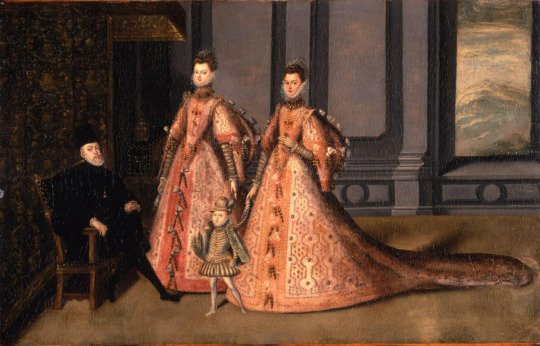
Portrait of Philip II of Spain and his 3 children (out of a total of 11 with his four wives) who survived to adulthood.
Shown are Isabella Clara Eugenia and Catalina Micaela, 2 of his daughters with his third wife, Elisabeth of Valois. In front of them is the future Philip III, his only surviving child with his fourth wife, Anna of Austria.
#Isabella Clara Eugenia of spain#philip ii#philip iii#house of habsburg#spanish monarchy#Catalina Micaela of Spain#long live the queue
52 notes
·
View notes